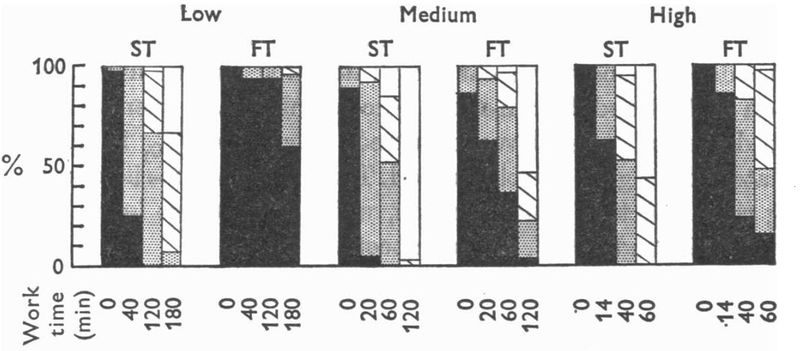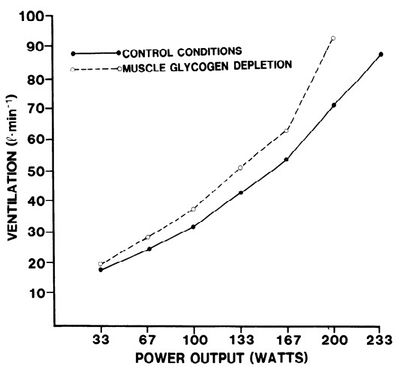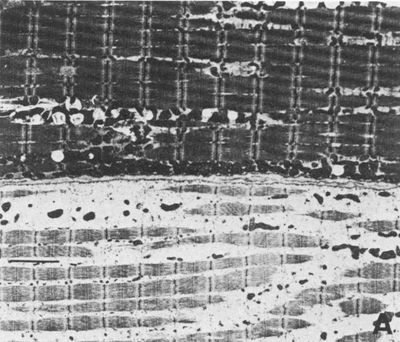Glycogen
Our bodies store carbohydrate as glycogen, the critical fuel supply for endurance running.
Contents
1 Introduction
While the human body has sufficient stores of fat to run vast distances, the supply of carbohydrate is quite limited. This carbohydrate store is in the form of Glycogen, a branching chain of glucose molecules.
- Burning glycogen for energy requires less oxygen than fat, making it more efficient. However, the store of glycogen is limited, and when the supply runs low we "hit the wall".
- Glycogen is stored primarily in the muscles, but that glycogen can only be used by the muscle it’s stored in and cannot flow through the blood to other places.
- Some glycogen is stored in the liver where it flows through the blood to all tissues. The human liver typically stores between 90 and 160 grams of Glycogen, or 350 to 650 Calories.
- Blood typically contains less than 20 calories of glucose. (This assumes 5 liters of blood and 100mg/dL of blood glucose, which is 5g of glucose.)
- Glycogen can also be created from protein via a process called gluconeogenesis, but not from fat.
- Eccentric exercise, such as Downhill Running, can cause DOMS and impair glycogen replenishment[1].
- Glycogen stores may not be replenished between daily hard runs, such as 10 miles at 80% of V̇O2max[2].
2 Glycogen Usage
 The contribution of different energy sources changes[3] with exercise intensity. These values were taken after 30 min. of exercise. Note that the total calories available from the blood (free fatty acid and glucose) remains about the same regardless of exercise intensity. |
 Percentage of energy from glycogen plotted against exercise intensity as percentage of V̇O2max. |
At low exercise intensity the majority of the energy comes from free fatty acids in the blood, with a little bit of blood glucose and a little bit of muscle triglyceride. As the exercise intensity increases the contribution of free fatty acids drops. The contribution of blood glucose increases with exercise intensity, but not as dramatically as the contribution of muscle glycogen. At higher intensity muscle glycogen is the major energy source and is critical for performance.
At 65% V̇O2max, the usage of different substrates changes over time. The reduced usage of muscle glycogen may be due to a reduction in the availability of the glycogen. Over the two hour period shown, the fat:carbohydrate ratio changes from around 55:45 to 65:35. This change would reduce power output (running speed) at the fixed percentage of V̇O2max (see ‘Glycogen Depletion and Breathing’ below).
3 Glycogen Depletion
The chart[4] below shows that muscles do not become glycogen depleted at the same time. At all intensities shown, slow twitch fibers become depleted before fast twitch. The depletion within a fiber type is also not equivalent, with some fibers becoming depleted while others are fully loaded. This pattern implies a pattern of Muscle Recruitment, where a subset of muscle fibers are recruited until they become exhausted, at which point other fibers are then used. As the slow twitch fibers become exhausted, fast twitch fibers are used in turn.

4 Glycogen Depletion and Breathing Rate
It requires more oxygen to produce energy from fat than carbohydrate[5]. This may be why higher intensity exercise harder shifts to burning more carbohydrate. When our muscles become depleted of glycogen, muscles are forced to burn more fat. At any given exercise intensity we will use more oxygen when we are glycogen depleted. This means our heart rate will be higher and out breathing will be deeper and faster. It also means our perceived exertion is much higher for a given pace when glycogen depleted. This effect is most noticeable at the end of a long run or a marathon race, and it becomes much harder to stay on target pace. In fact, it can become up to 20% harder and this can be the difference between relaxed easy breathing and panting for breath. This increased demand for oxygen can often be seen in the calculated running efficiency.

5 Glycogen Depletion and Muscle Damage
Muscle biopsies taken after a marathon show damage to muscle fibers, but this damage appears focused on a subset of the fibers[6]. Some fibers show no damage, but adjacent fibers are badly affected. The damaged fibers are depleted of Glycogen and lipids (fat). It seems reasonable to me that this pattern of selective damage is due to the pattern of fibers recruitment, with the fibers that are recruited first becoming both glycogen depleted and damaged. Similar damage can be seen with Delayed Onset Muscle Soreness. The images below are taken from the gastrocnemius (calf), 24-48 hours after a marathon race,
6 Further reading
For more details see http://en.wikipedia.org/wiki/Glycogen
7 References
- ↑ O'Reilly, KP.; Warhol, MJ.; Fielding, RA.; Frontera, WR.; Meredith, CN.; Evans, WJ. (Jul 1987). "Eccentric exercise-induced muscle damage impairs muscle glycogen repletion.". J Appl Physiol 63 (1): 252-6. Template:citation/identifier.
- ↑ Costill, DL.; Bowers, R.; Branam, G.; Sparks, K. (Dec 1971). "Muscle glycogen utilization during prolonged exercise on successive days.". J Appl Physiol 31 (6): 834-8. Template:citation/identifier.
- ↑ 3.0 3.1 Regulation of endogenous fat and carbohydrate metabolism in relation to exercise intensity and duration http://ajpendo.physiology.org/content/265/3/E380.short
- ↑ Selective glycogen depletion in skeletal muscle fibers of man following sustained contractions http://www.ncbi.nlm.nih.gov/pmc/articles/PMC1331072/
- ↑ 5.0 5.1 Effect of glycogen depletion on the ventilatory response to exercise http://jap.physiology.org/content/54/2/470.short
- ↑ Warhol, MJ.; Siegel, AJ.; Evans, WJ.; Silverman, LM. (Feb 1985). "Skeletal muscle injury and repair in marathon runners after competition.". Am J Pathol 118 (2): 331-9. Template:citation/identifier.



